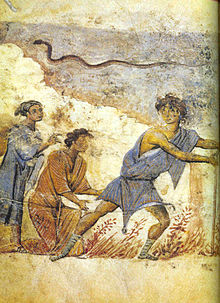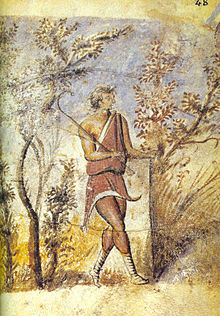Theriaca (poem)


The Theriaca (Ancient Greek: Θηριακά) is the longest surviving work of the 2nd-century BC Greek poet Nicander of Colophon.
It is a 958-line hexameter poem describing the nature of venomous creatures, including snakes, spiders and scorpions, and the wounds that they inflict.[1]
Nicander also wrote the companion work Alexipharmaca, which explored other poisons and venoms.
Etymology[edit]
The title is the Latinized form of the Greek neuter plural adjective θηριακά (thēriaka), "having to do with venomous animals",[2] which in turn derives from Ancient Greek: θηρίον (thērion), "wild animal".[3] A corresponding English noun, theriac, also exists.[4]
Content[edit]
It has been noted that Theriaca is a poem not solely concerned with its intended subject matter, given its "arcane language".[5] Nicander makes references to a drakōn, however it is likely this term is utilized to refer to an Aesculapian snake rather than a dragon in the contemporary perception of the word.[6]
References[edit]
- ^ "Nicander of Colophon". University of Chicago.
- ^ θηριακός. Liddell, Henry George; Scott, Robert; A Greek–English Lexicon at the Perseus Project.
- ^ θηρίον in Liddell and Scott.
- ^ "theriaca". dictionary.com.
- ^ Overduin, Floris (December 2014). "The Anti-Bucolic World Of Nicander's 'Theriaca'". The Classical Quarterly. 64 (2): 623. doi:10.1017/S0009838814000342. hdl:2066/133161. JSTOR 43905601. S2CID 170453942. Retrieved 9 May 2021.
- ^ Senter, Phil; Mattox, Uta; Haddad, Eid. "Snake to Monster: Conrad Gessner's Schlangenbuch and the Evolution of the Dragon in the Literature of Natural History". Journal of Folklore Research. 53 (1): 74. doi:10.2979/jfolkrese.53.1-4.67. S2CID 163428518. Retrieved 25 March 2021.
Further reading[edit]
- Weitzmann, Kurt, ed., Age of spirituality: late antique and early Christian art, third to seventh century, no. 226, 1979, Metropolitan Museum of Art, New York, ISBN 9780870991790; full text available online from The Metropolitan Museum of Art Libraries
